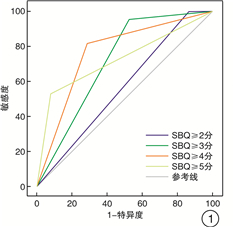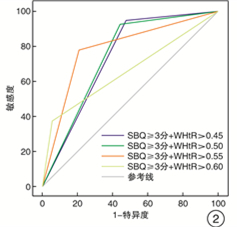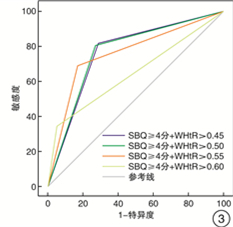Modification and accuracy of the STOP-Bang questionnaire for screening obstructive sleep apnea in adults
-
摘要: 目的 评估STOP-Bang问卷(SBQ)筛查成人阻塞性睡眠呼吸暂停(OSA)的准确性,并结合研究对象的体型特征,建立适合该人群的体重指数(BMI)、颈围(NC)、年龄、SBQ总分截断值,并评估SBQ与腰高比(WHtR)联合筛查的准确性。方法 选取2019年10月—2020年11月在贵州医科大学附属医院以打鼾为主要症状就诊的218例可疑OSA患者为研究对象。均完整填写SBQ及进行整夜PSG监测,SBQ筛查与PSG诊断采用盲法同步测试。以PSG结果作为金标准,根据呼吸暂停低通气指数将研究对象分为中重度OSA患病组和非患病组,以SBQ筛查结果将研究对象分为中重度OSA阳性组和中重度OSA阴性组。将问卷结果与金标准以四格表的形式列出,通过调整年龄、BMI、NC、SBQ总分截断值,计算问卷的敏感度、特异度、阳性预测值(PPV)、阴性预测值(NPV)、约登指数,并绘制ROC曲线,计算曲线下面积(AUC),确定最佳的截断值。并将改良版SBQ与WHtR进行联合诊断,评价联合筛查的准确性。结果 218例全部完成实验,中重度OSA患病组共159例(72.94%),原SBQ对中重度OSA的预测敏感度为93.71%,特异度为47.46%,PPV为82.80%,NPV为73.70%,约登指数为0.41,AUC为0.71。将BMI截断值调整到30 kg/m2、NC截断值40 cm、年龄截断值50岁时的改良版SBQ预测中重度OSA的敏感度为95.60%,特异度为47.46%,PPV为83.10%,NPV为80.00%,约登指数为0.43,AUC为0.72。改良版SBQ总分以≥4分作为截断值时约登指数、AUC最高,分别为0.54、0.77;改良版SBQ≥3分与WHtR>0.55联合筛查时约登指数、AUC最高,分别为0.58、0.79。结论 SBQ可有效识别中重度OSA,使用改良版SBQ(BMI>30 kg/m2、NC>40 cm、年龄>50岁)可以获得更好的筛查准确性,改良版SBQ总分以≥4分作为截断值筛查准确性更高,SBQ总分=3分且WHtR>0.55者可归入中重度OSA高风险,改良版SBQ可作为识别中重度OSA的筛查工具。
-
关键词:
- 睡眠呼吸暂停,阻塞性 /
- STOP-Bang问卷
Abstract: Objective To assess the accuracy of the STOP-Bang questionnaire(SBQ) about screening for obstructive sleep apnea(OSA) in adults, and to establish appropriate cutoffs for body mass index(BMI), neck circumference(NC), age, and SBQ score for this population in combination with the body size characteristics of the study subjects, and to evaluate the accuracy of the SBQ for combined screening with waist to height ratio(WHtR).Methods The data were collected from October, 2019 to November, 2020 at the Affiliated Hospital of Guizhou Medical University, and 218 patients with suspicious OSA were included in this study, all of them completed the SBQ and underwent overnight PSG. SBQ screening and PSG were tested in a blinded concurrent manner. Using the PSG results as the gold standard, the subjects were divided into a diseased group with moderate to severe OSA and a non-diseased group based on apnea hypopnea index. According to SBQ screening results, the subjects were divided into a positive group with moderate severe OSA and negative group. And calculated in the form of four-fold table, the optimal cutoffs were determined by adjusting age, BMI, NC, and SBQ score cutoffs, and calculating the sensitivity, specificity, positive predictive value(PPV), negative predictive value(NPV), Youden index, and area under the receiver operating characteristic curve(ROC). And the modified version of SBQ was combined with WHtR for joint diagnosis to evaluate the accuracy of combined screening.Results With all 218 patients completing the experiment, 159(72.94%) patients were in the moderate-severe group. The original SBQ had a sensitivity of 93.71%, specificity of 47.46%, PPV of 82.80%, NPV of 73.70%, Youden index of 0.41, and area under the ROC curve(AUC) of 0.71 for predicting moderate to severe OSA. When adjusting the BMI cutoff to 30 kg/m2, NC cutoff to 40 cm, and age cutoff to 50 years, the modified SBQ had a sensitivity of 95.60%, specificity of 47.46%, PPV of 83.10%, NPV of 80.00%, Youden index of 0.43, and AUC of 0.72 for predicting moderate to severe OSA. When the modified SBQ score was 4 or more as the cutoff value, the highest Youden index and AUC were 0.54, 0.77 respectively. When the modified SBQ≥3 points were combined with WHtR>0.55, the highest Youden index and AUC were 0.58, 0.79 respectively.Conclusion SBQ is effective in screening for moderate to severe OSA and better screening accuracy can be achieved by using a modified version of the SBQ(BMI>30 kg/m2, NC>40 cm, age>50 years). The maximum diagnostic accuracy can be achieved when the modified SBQ total score was 4 or more as the cutoff. Those with the modified SBQ total score=3 and WHtR>0.55 can be classified as high risk for moderate to severe OSA, and the modified version of SBQ can be a screening tool to identify moderate to severe OSA.-
Key words:
- sleep apnea, obstructive /
- STOP-Bang questionnaires
-

-
表 1 基本资料及SBQ得分在患病组和非患病组间的分布
项目 总 患病组 非患病组 t或χ2 P 性别(男/女) 169/49 134/25 35/24 15.38 < 0.001 年龄/岁 42.11±12.12 42.95±11.74 39.85±12.93 1.69 0.093 BMI/(kg·m-2) 26.83±3.77 27.54±3.52 24.93±3.78 4.76 < 0.001 NC/cm 38.08±3.79 38.76±3.35 36.25±4.30 4.55 < 0.001 腰围/cm 96.20±11.02 99.05±9.74 88.53±10.65 6.91 < 0.001 身高/cm 166.31±6.89 166.57±6.93 165.61±6.80 0.91 0.364 WHtR 0.58±0.07 0.60±0.06 0.53±0.06 6.76 < 0.001 AHI/(次·h-1) 43.50±28.92 56.09±23.52 9.57±4.05 15.09 < 0.001 最低血氧饱和度/% 64.96±21.13 57.61±19.97 84.76±6.10 -10.25 < 0.001 SBQ得分/分 4.19±1.56 4.70±1.32 2.81±1.31 9.39 < 0.001 表 2 SBQ各项问题回答“是”在男性、女性研究对象中的分布
例(%) 问卷 回答“是” χ2 P 总 男性 女性 打鼾:您的鼾声大吗(高于谈话声或隔着房间门就能听到)? 202(92.66) 158(93.49) 44(89.80) 0.76 0.380 疲劳:您经常在白天感觉疲劳、乏力或困倦吗? 163(74.77) 133(78.70) 30(61.22) 6.12 0.010 观察:曾经有旁人观察到您在睡眠中有呼吸停止的情况吗? 133(61.01) 110(65.09) 23(46.94) 5.26 0.020 血压:您患有高血压或目前正在进行高血压治疗吗? 94(43.12) 72(42.60) 22(44.90) 0.08 0.780 BMI/(kg·m-2) >35 2(0.92) 2(1.18) 0(0) 0.58 0.450 >32 17(7.80) 14(8.28) 3(6.12) 0.25 0.620 >30 46(21.10) 39(23.08) 7(14.29) 1.75 0.190 >28 86(39.45) 70(41.42) 16(32.65) 1.21 0.270 >26 134(61.47) 111(65.68) 23(46.94) 5.61 0.020 >24 167(76.61) 136(80.47) 31(63.27) 6.25 0.010 年龄>50岁? 58(26.61) 37(21.89) 21(42.86) 8.51 0.003 NC/cm >40 48(22.02) 48(28.40) 0(0) 17.77 < 0.001 >38 102(46.79) 100(59.17) 2(4.08) 46.10 < 0.001 >36 155(71.10) 143(84.62) 12(24.49) 66.53 < 0.001 性别:男性? 169(77.52) 169(100.00) 0(0) 217.00 < 0.001 SBQ总分≥3分 183(83.94) 156(92.31) 27(55.10) 38.84 < 0.001 表 3 年龄>50岁组不同BMI截断值SBQ对中重度OSA的预测价值
项目 BMI35 BMI32 BMI30 BMI28 BMI26 BMI24 高风险患者/ 例(%) 180(82.57) 180(82.57) 183(83.94) 186(85.32) 190(87.16) 195(89.45) 低风险患者/ 例(%) 38(17.43) 38(17.43) 35(16.06) 32(14.68) 28(12.84) 23(10.55) 敏感度/[%,(95%CI)] 93.71(88.70~ 96.90) 93.71(88.70~ 96.90) 95.60(91.10~ 98.20) 96.23(92.00~ 98.60) 96.23(92.00~ 98.60) 96.86(92.80~ 99.00) 特异度/[%,(95%CI)] 47.46(34.30~ 60.90) 47.46(34.30~ 60.90) 47.46(34.30~ 60.90) 44.07(31.20~ 57.60) 37.29(25.00~ 50.90) 30.51(19.20~ 43.90) PPV/[%,(95%CI)] 82.80(76.50~ 88.00) 82.80(76.50~ 88.00) 83.10(76.80~ 88.20) 82.30(76.00~ 87.50) 80.50(74.20~ 85.90) 79.00(72.60~ 84.50) NPV/[%,(95%CI)] 73.70(56.90~ 86.60) 73.70(56.90~ 86.60) 80.00(63.10~ 91.60) 81.30(63.60~ 92.80) 78.60(59.00~ 91.70) 78.30(56.30~ 92.50) 约登指数 0.41 0.41 0.43 0.40 0.34 0.27 AUC/(95%CI) 0.71(0.64~ 0.77) 0.71(0.64~ 0.77) 0.72(0.65~ 0.77) 0.70(0.64~ 0.76) 0.67(0.60~ 0.73) 0.64(0.57~ 0.70) 表 4 年龄>45岁组不同BMI截断值SBQ对中重度OSA的预测价值
项目 BMI35 BMI32 BMI30 BMI28 BMI26 BMI24 高风险患者/例(%) 184(84.40) 184(84.40) 187(85.78) 189(86.70) 189(86.70) 196(89.91) 低风险患者/例(%) 34(15.60) 34(15.60) 31(14.22) 29(13.30) 29(13.30) 22(10.09) 敏感度/[%,(95%CI)] 94.34(89.50~ 97.40) 94.34(89.50~ 97.40) 96.23(92.00~ 98.60) 96.23(92.00~ 98.60) 96.23(92.00~ 98.60) 96.86(92.80~ 99.00) 特异度/[%,(95%CI)] 42.37(29.60~ 55.90) 42.37(29.60~ 55.90) 42.37(29.60~ 55.90) 38.98(26.50~ 52.60) 38.98(26.50~ 52.60) 28.81(17.80~ 42.10) PPV/[%,(95%CI)] 81.50(75.10~ 86.90) 81.50(75.10~ 86.90) 81.80(75.50~ 87.10) 81.00(74.60~ 86.30) 81.00(74.60~ 86.30) 78.60(72.20~ 84.10) NPV/[%,(95%CI)] 73.50(55.60~ 87.10) 73.50(55.60~ 87.10) 80.60(62.50~ 92.50) 79.30(60.30~ 92.00) 79.30(60.30~ 92.00) 77.30(54.60~ 92.20) 约登指数 0.37 0.37 0.39 0.35 0.35 0.26 AUC/(95%CI) 0.68(0.62~ 0.75) 0.68(0.62~ 0.75) 0.69(0.63~ 0.75) 0.68(0.61~ 0.74) 0.68(0.61~ 0.74) 0.63(0.56~ 0.69) 表 5 年龄>42岁组不同BMI截断值SBQ对中重度OSA的预测价值
项目 BMI35 BMI32 BMI30 BMI28 BMI26 BMI24 高风险患者/例(%) 186(85.32) 186(85.32) 189(86.70) 191(87.61) 195(89.45) 199(91.28) 低风险患者/例(%) 32(14.68) 32(14.68) 29(13.30) 27(12.39) 23(10.55) 19(8.72) 敏感度/[%,(95%CI)] 95.60(91.10~ 98.20) 95.60(91.10~ 98.20) 97.48(93.70~ 99.30) 97.48(93.70~ 99.30) 97.48(93.70~ 99.30) 98.11(94.60~ 99.60) 特异度/[%,(95%CI)] 42.37(29.60~ 55.90) 42.37(29.60~ 55.90) 42.37(29.60~ 55.90) 38.98(26.50~ 52.60) 32.20(20.60~ 45.60) 27.12(16.40~ 40.30) PPV/[%,(95%CI)] 81.70(75.40~ 87.00) 81.70(75.40~ 87.00) 82.00(75.80~ 87.20) 81.20(74.90~ 86.40) 79.50(73.10~ 84.90) 78.40(72.00~ 83.90) NPV/[%,(95%CI)] 78.10(60.00~ 90.70) 78.10(60.00~ 90.70) 86.20(68.30~ 96.10) 85.20(66.30~ 95.80) 82.60(61.20~ 95.00) 84.20(60.40~ 96.60) 约登指数 0.38 0.38 0.40 0.36 0.30 0.25 AUC/(95%CI) 0.69(0.62~ 0.75) 0.69(0.62~ 0.75) 0.70(0.63~ 0.76) 0.68(0.62~ 0.74) 0.65(0.58~ 0.71) 0.63(0.56~ 0.69) 表 6 在整体研究对象中调整NC截断值SBQ对中重度OSA预测价值
项目 NC40 NC38 NC36 高风险患者/例(%) 183(83.94) 187(85.78) 191(87.61) 低风险患者/例(%) 35(16.06) 31(14.22) 27(12.39) 敏感度/[%,(95%CI)] 95.60(91.10~98.20) 96.23(92.00~98.60) 97.48(93.70~99.30) 特异度/[%,(95%CI)] 47.46(34.30~60.90) 42.37(29.60~55.90) 38.98(26.50~52.60) PPV/[%,(95%CI)] 83.10(76.80~88.20) 81.80(75.50~87.10) 81.20(74.90~86.40) NPV/[%,(95%CI)] 80.00(63.10~91.60) 80.60(62.50~92.50) 85.20(66.30~95.80) AUC/(95%CI) 0.72(0.65~0.77) 0.69(0.63~0.75) 0.68(0.62~0.74) 约登指数 0.43 0.39 0.36 表 7 女性研究对象中调整NC截断值SBQ对中重度OSA预测价值
项目 NC40 NC38 NC36 高风险患者/例(%) 183(83.94) 184(84.40) 187(85.78) 低风险患者/例(%) 35(16.06) 34(15.60) 31(14.22) 敏感度/[%,(95%CI)] 95.60(91.10~98.20) 95.60(91.10~98.20) 96.86(92.80~99.00) 特异度/[%,(95%CI)] 47.46(34.30~60.90) 45.76(32.70~59.20) 44.07(31.20~57.60) PPV/[%,(95%CI)] 83.10(76.80~88.20) 82.60(76.30~87.80) 82.40(76.10~87.50) NPV/[%,(95%CI)] 80.00(63.10~91.60) 79.40(62.10~91.30) 83.90(66.30~94.50) AUC/(95%CI) 0.72(0.65~0.77) 0.71(0.64~0.77) 0.71(0.64~0.76) 约登指数 0.43 0.41 0.41 表 8 改良版SBQ及联合WHtR对中重度OSA预测价值
项目 敏感度/[%,
(95%CI)]特异度/[%,
(95%CI)]PPV/[%,
(95%CI)]NPV/[%,
(95%CI)]AUC/
(95%CI)约登指数 SBQ≥2分 100(97.7~ 100.00) 13.56(6.00~ 25.00) 75.70(69.30~ 81.40) 100(63.10~ 100.00) 0.57(0.50~ 0.64) 0.14 SBQ≥3分 95.60(91.10~ 98.20) 47.46(34.30~ 60.90) 83.10(76.80~ 88.20) 80.00(63.10~ 91.60) 0.72(0.65~ 0.77) 0.43 SBQ≥4分 82.39(75.60~ 88.00) 71.19(57.90~ 82.20) 88.50(82.20~ 93.20) 60.00(47.60~ 71.50) 0.77(0.70~ 0.82) 0.54 SBQ≥5分 53.46(45.40~ 61.40) 91.53(81.30~ 97.20) 94.40(87.50~ 98.20) 42.20(33.50~ 51.20) 0.73(0.66~ 0.78) 0.45 SBQ≥3分+ WHtR>0.45 94.97(90.30~ 97.80) 52.54(39.10~ 65.70) 84.40(78.20~ 89.30) 79.50(63.50~ 90.70) 0.74(0.67~ 0.80) 0.48 SBQ≥3分+ WHtR>0.50 93.08(88.00~ 96.50) 55.93(42.40~ 68.80) 85.10(78.90~ 90.00) 75.00(59.70~ 86.80) 0.75(0.68~ 0.80) 0.49 SBQ≥3分+ WHtR>0.55 77.99(70.70~ 84.20) 79.66(67.20~ 89.00) 91.20(85.10~ 95.40) 57.30(45.90~ 68.20) 0.79(0.73~ 0.84) 0.58 SBQ≥3分+ WHtR>0.60 37.11(29.60~ 45.10) 94.92(85.90~ 98.90) 95.20(86.50~ 99.00) 35.90(28.40~ 44.00) 0.66(0.59~ 0.72) 0.32 SBQ≥4分+ WHtR>0.45 82.39(75.60~ 88.00) 71.19(57.90~ 82.20) 88.50(82.20~ 93.20) 60.00(47.60~ 71.50) 0.77(0.70~ 0.82) 0.54 SBQ≥4分+ WHtR>0.50 81.13(74.20~ 86.90) 72.88(59.70~ 83.60) 89.00(82.70~ 93.60) 58.90(46.80~ 70.30) 0.77(0.71~ 0.83) 0.54 SBQ≥4分+ WHtR>0.55 69.81(62.00~ 76.80) 83.05(71.00~ 91.60) 91.70(85.30~ 96.00) 50.50(40.20~ 60.80) 0.76(0.70~ 0.82) 0.53 SBQ≥4分+ WHtR>0.60 34.59(27.20~ 42.50) 94.92(85.90~ 98.90) 94.80(85.60~ 98.90) 35.00(27.60~ 42.90) 0.65(0.58~ 0.71) 0.30 -
[1] 中国医师协会睡眠医学专业委员会. 成人阻塞性睡眠呼吸暂停多学科诊疗指南[J]. 中华医学杂志, 2018, 98(24): 1902-1914. doi: 10.3760/cma.j.issn.0376-2491.2018.24.003
[2] 张婷婷, 黄燕. 成人阻塞性睡眠呼吸暂停筛查问卷的应用价值[J]. 中华健康管理学杂志, 2020, 14(5): 483-486. doi: 10.3760/cma.j.cn115624-20200316-00180
[3] Amra B, Rahmati B, Soltaninejad F, et al. Screening Questionnaires for Obstructive Sleep Apnea: An Updated Systematic Review[J]. Oman Med J, 2018, 33(3): 184-192. doi: 10.5001/omj.2018.36
[4] 张成, 马靖, 钟益珏, 等. STOP-Bang问卷在阻塞性睡眠呼吸暂停低通气综合征筛查中的应用价值[J]. 临床内科杂志, 2017, 34(12): 851-852. https://www.cnki.com.cn/Article/CJFDTOTAL-ZDDZ202103015.htm
[5] 裴翀, 丁震, 李秀. 阻塞性睡眠呼吸暂停三种常用量表的比较分析[J]. 临床肺科杂志, 2019, 24(11): 1956-1959. doi: 10.3969/j.issn.1009-6663.2019.11.005
[6] Öztürk N, Dilektşlı AG, Çetino luǧED, et al. Diagnostic Accuracy of a Modified STOP-BANG Questionnaire with National Anthropometric Obesity Indexes[J]. Turk Thorac J, 2019, 20(2): 103-107. doi: 10.5152/TurkThoracJ.2018.18074
[7] Chung F, Abdullah HR, Liao P. STOP-Bang Questionnaire: A Practical Approach to Screen for Obstructive Sleep Apnea[J]. Chest, 2016, 149(3): 631-638. doi: 10.1378/chest.15-0903
[8] 余洋, 梅伟, 崔永华. S-B评分量表对OSAHS预测作用的初步评价[J]. 临床耳鼻咽喉头颈外科杂志, 2012, 26(6): 256-259. https://www.cnki.com.cn/Article/CJFDTOTAL-LCEH201206006.htm
[9] 中华医学会呼吸病学分会睡眠呼吸障碍学组. 阻塞性睡眠呼吸暂停低通气综合征诊治指南(2011年修订版)[J]. 中华结核和呼吸杂志, 2012, 35(1): 9-12. doi: 10.3760/cma.j.issn.1001-0939.2012.01.007
[10] Gamaldo C, Buenaver L, Chernyshev O, et al. Evaluation of Clinical Tools to Screen and Assess for Obstructive Sleep Apnea[J]. J Clin Sleep Med, 2018, 14(7): 1239-1244. doi: 10.5664/jcsm.7232
[11] Chung F, Yegneswaran B, Liao P, et al. STOP questionnaire: a tool to screen patients for obstructive sleep apnea[J]. Anesthesiology, 2008, 108(5): 812-821. doi: 10.1097/ALN.0b013e31816d83e4
[12] 中国肥胖问题工作组数据汇总分析协作组. 我国成人体重指数和腰围对相关疾病危险因素异常的预测价值: 适宜体重指数和腰围切点的研究[J]. 中华流行病学杂志, 2002, 23(1): 10-15. doi: 10.3760/j.issn:0254-6450.2002.01.025
[13] Li Z, Du L, Li Y, et al. Characterization of primary symptoms leading to Chinese patients presenting at hospital with suspected obstructive sleep apnea[J]. J Thorac Dis, 2014, 6(5): 444-451.
[14] Ong TH, Raudha S, Fook-Chong S, et al. Simplifying STOP-BANG: use of a simple questionnaire to screen for OSA in an Asian population[J]. Sleep Breath, 2010, 14(4): 371-376. doi: 10.1007/s11325-010-0350-7
[15] Banhiran W, Durongphan A, Saleesing C, et al. Diagnostic properties of the STOP-Bang and its modified version in screening for obstructive sleep apnea in Thai patients[J]. J Med Assoc Thai, 2014, 97(6): 644-654.
[16] Chung F, Subramanyam R, Liao P, et al. High stopbang score indicates a high probability of obstructive sleep apnea[J]. Br J Anaesth, 2012, 108(5): 768-775. doi: 10.1093/bja/aes022
[17] Xia M, Liu S, Ji N, et al. BMI 35 kg/m2 does not fit everyone: a modified STOP-Bang questionnaire for sleep apnea screening in the Chinese population[J]. Sleep Breath, 2018, 22(4): 1075-1082. doi: 10.1007/s11325-017-1610-6
[18] 栗宇, 崔晶, 任继平, 等. 肥胖指标在阻塞性睡眠呼吸暂停低通气综合征筛查中的应用[J]. 中国耳鼻咽喉头颈外科, 2019, 26(4): 211-214. https://www.cnki.com.cn/Article/CJFDTOTAL-EBYT201904013.htm
[19] Silva GE, Vana KD, Goodwin JL, et al. Identification of patients with sleep disordered breathing: comparing the four-variable screening tool, STOP, STOP-Bang, and Epworth Sleepiness Scales[J]. J Clin Sleep Med, 2011, 7(5): 467-472. doi: 10.5664/JCSM.1308
-





 下载:
下载:

